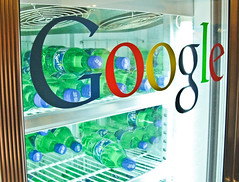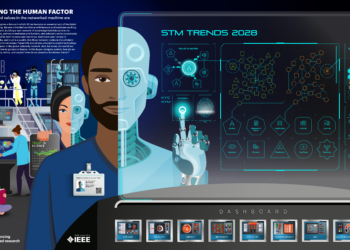Scholarly communications, and perhaps publishing in general, is organized around two kinds of texts, which sit at opposite ends of a continuum. On one side we have the fixed text. This is the definitive, the “final” version of an utterance (though, as Keynes remarked, in the long run we are all dead–so much for “final”). In the scholarly world the fixed text is held in high regard. What is the version of record? What is your institution’s preservation strategy? The fixed text traditionally resided in the fixed medium of print, but proponents of such texts have brought to digital media many of the properties of the print medium. This is part of the underlying philosophy of the ubiquitous PDF and it also plays a role in such preservation services as Portico and LOCKSS.
On the other end of the continuum is the dynamic nature of conversation. In the pre-Internet world conversations took place wherever humans gathered, whether in corridors or at conferences. The “texts” of such conversations, now increasingly migrating to the Internet, differ from those of a formally published article or book. They probe a topic rather than seek to define it; their expressions are provisional and dynamic; often the subject of such conversations is a fixed text. What do you think of Professor Jones’s book? Have you seen Smith’s article? The fixed and the dynamic coexist happily, with each understanding and respecting the prerogatives of the other.
Then came Wikipedia. By integrating the dynamic nature of human discussion with the form and expectations of an established genre, Wikipedia challenged the boundaries between fixed and dynamic. When does a conversation become something that is to be recorded? If recorded, how can we find it when we go to look for it later? How do we evaluate such a record? Does it have the same status as something prepared in the traditional manner? Can we think of a blog and an article in the same breath? Whatever we might feel about Wikipedia, it opened up a new way of thinking about texts by asserting that all texts are dynamic, however fixed they may appear to a user who stumbles on one. It is both instructive and amusing to look up the article on “Wikipedia” in the Wikipedia. It tries to get the story right, and it has gone through countless (and continuing) revisions to get there.
The mightily dynamic — meaning, in part, evanescent — world of Web 2.0 focuses largely on the conversational end of the continuum, with comment inspiring comment, which in turn inspires response. A blog post gives rise to a thread on Facebook, which triggers a hashtag on Twitter, which culminates in another blog post. An essay written about this phenomenon (and published in a traditonal journal) may get listed on LinkedIn to assert one’s bona fides. A casual reader of the TechCrunch or ReadWriteWeb blogs will be astounded to discover how many social media companies there are. Yes, of course many will disappear in a few years, leaving perhaps just Facebook and one or two others standing (or just Facebook), but there seems little doubt that social media is here to stay. The question for scholarly communications is how social media will be integrated with fixed texts, unless we imagine that the fixed text has seen its day.
As has been often remarked (and particularly eloquently by the Kitchen’s own David Crotty), scientists have better things to do than to spend time with social media. For social media to work–for there to be a “Facebook for Scientists” — the rewards culture of the academy must change. If you could get tenure on the strength of your Twitter stream, many more researchers would be using Twitter. But even that does not seem enough. As much as I like Twitter (it has become my principal news source after the New York Times), it is entirely deficient in so many ways. It lacks substantive content; it is filled with irritating personal information; it has no ambitions to supplant the fixed content required by the academy. It is a curated news feed–neither more nor less.
Google’s new entry into this world, Google+ (pronounced “Google Plus”) in some respects seems to be an attempt to move from one end, the dynamic one, part of the way, though only a small part, toward the other. Google+ apparently was conceived at the intersection of Facebook and Twitter, though one might catch a glimpse of LinkedIn on a side street. (One feature, Hangouts, for video sharing, is likely to become a platform for some of the Internet’s darker activities.) I wish Google had brought Google Scholar into its thinking as well, but at least Blogger seems to be partly represented. Indeed, Google+ may in time come to supplant blogs. I have been pondering what it would mean to relaunch the Scholarly Kitchen on the Google+ platform. This is not just a technical matter; at some point you find yourself saying, Enough with Google! Let’s diversify the portfolio. But if Google+ were to realize its greatest ambitions, all virtual communication would take place there. Scary.
There are generally two strategies for those who want to bring the conversational aspect of social media to scholarly communications. One strategy is to start with the fixed text itself and then to attempt to wrap a layer of social media around it. The other is to step into the flow of conversation and drop a fixed text into it. The latter is what is hinted at in Google+, which uses the metaphor of the “stream” to describe the flow of comments and responses. But what are the limits of a comment? Why not simply insert an essay or even a long-form text and allow the stream to flow over and around it, stopping for a moment, as occasion and curiosity warranted, to leave a remark?
I have been testing this myself since the launch of Google+ a month ago. Like just about all other early invitees to Google+, I have been struggling to figure out just how this new service works. (A footnote: I was surprised to find that invitations to Google+ were something of a status item. On a recent trip to New York, several people begged me to send invitations to them. This was the first and almost certainly the last time in my life that I ever possessed anything even remotely cool. I wish I had had Google+ when I was in high school.) Some of my posts got lost; I even made the unforgiveable blunder of adding a “+1” — a vote of approval — for some of my own posts. But after a while you get the hang of it. You soon realize that you can put everyone into a “following” group (called a “circle”), review their posts, and then selectively eliminate the overly loquacious or the embarrassingly personal. The implication of this is that you can develop tailored feeds or streams. Thus I am in the process of putting together my primary stream now in which all the people I follow are in some way involved professionally with digital media and scholarly communications. The potential for streams for, say, cultural anthropology or bioinformatics is clear.
I experimented with a post of my own, drafted for the express purpose of trying to learn how Google + could be useful. (I am not providing links here because the links bring the user back to my personal pages, where my settings are accessible. Presumably this kink will be worked out in subsequent releases.) The post is longer than a Tweet (which has a 140-character limit), but shorter than a blog post, at least those posts one associates with the Scholarly Kitchen. It bears no resemblance to an article, of course, but one wonders where this could go; of particular significance is the fact that Google assigns a fixed URL to the post. With a fixed URL in hand, can a fixed text be far behind? Two people thus far who “follow” me on Google+ have added comments — which means that they have me in their “circles.” I have never met either individual, which is part of the point of social media, a McLuhanesque extension of the self with no real antecedent. The post as presented here has been plucked from the stream — or streams, as it appears one way on my stream, but in a different way in the streams of all those who include me in their “circles.” Following the stream is like skimming the headlines of a newspaper or running your eye over a list of abstracts. Over time people will learn how to craft posts such that the reader stops, pays attention, clicks on a link, etc. Google+ is one month old. It will be a different service by the new year.
While scholarly publishers spend much of their time trying to figure out how to hold onto their library revenues (a backward-looking strategy, since libraries play a declining role in scholarly communications overall), it might be useful to experiment with Google+ to see where it can go. The first thing to do, of course, is to get on Google + (I hear that some people are selling invitations), but the more challenging task will be to amass a group of people to put your publications into their circles to follow your posts. A publisher might experiment by posting abstracts of articles, study the outcome, and then rethink the strategy. Such a publisher might also comment on others’ posts and then embed links back to the publisher’s own site. The Wikipedia is already being used in this way, as a text infiltrated by established and prestigious publishers such that it serves as a source of Web traffic.
Such an experiment underscores the fact that social media is at this time primarily a promotional tool for scholarly publishers. It is one thing to post an abstract on Google+, quite another to think of Google+ as a formal and primary publishing platform. It will take a long time for Google+ or any other new social service to challenge the primacy of the institutional sales of an established journal. On the other hand, there is a feeling of inevitability about this: social media is not going away and will keep nibbling on the perimeter of scholarly communications until we all wake up to find it has taken a big bite. An interesting question is to attempt to evaluate two long-term futures to determine which becomes dominant, the future of social media in scholarly communications and the future of selling PDFs to libraries. My vote (+1) is with the former.
Discussion
7 Thoughts on "The New Face of Social Media"
“The implication of this [in Google+] is that you can develop tailored feeds or streams.” You can do this with Twitter lists or RSS feeds. The governing factor is still the whims of the author. If the New York Times decides to start spewing out Tales of Peter Cottontail through its Economy RSS feed, you have few options.
I am not sure what the advantages of posting text to Google + are over posting to Facebook? I understand that Facebook may seem amateurish to the scholarly community, but the functionality is the same.
I like the idea of conversations–and social media at best fosters conversation in more quarters and invites participation.When thoughts turn to speech and then to action and are shared and refined or built upon along the path–it is all good.
I didn’t delete my invites–will have to review. I need to revise my personal communication plan going forward. So many passwords, so little time.
For professional purposes or otherwise–it would be nice if these companies worked more like a utility with their name in the background and we can all access one another as we do by phone or email. Or if the logo was in the background rather than constantly up front. If we have our prefered services and folks can know which one we have, but the discussion is not always about the “name” of the service. I’ll talk to you on AT&T or come over and watch my Zenith. We don’t refer to our email by brand though it often comes out in our address, but not always. Some still say Xerox when they mean photocopy. Seems we are constantly stating our brand loyalties. I don’t mind stating loyalty to good products, good product design is exciting–wary and weary of idolizing companies.
One interesting thing I’ve noticed at the scientific meetings I’ve attended this summer is that researchers are more and more reluctant to present any unpublished data in their talks. It’s a bit at odds with the prevalent zeitgeist of sharing and being social and open with everything. Those I’ve spoken with have stopped discussing work that hasn’t yet been fully exploited, mostly out of fear of the widespread dissemination of their preliminary data. Jobs and funding are so hard to come by these days that no one seems willing to take a chance on being scooped.
As Phil Davis often notes, scientists do share their data, but they’re very careful about how they do it. In an age where the smallest public uttering gets preserved and shown to the world, many are being even more careful and withholding information they might have shared at meetings in years past.
I think for any social tool to see widespread use, it’s going to have to incorporate a high level of privacy and control, a way to mirror the small, trusted and private networks scientists already use.
David
Interesting point. We have found on LIn Group EBooks, Ereaders, Digital Content, that professionals who can offer good info to the group often do not share. It is a thriving Group with lots of good info, but it often comes from articles or independents. I think folks don’t want to feel they speak for their company. And publishing tends to be reserved, let alone competitive. If vendors share, it appears as solicitation. Feels like backlash. Also, the downside of teams and cooperation can be group process taking credit for one person’s brilliance. Just a few thoughts.
Interesting comments to an interesting post. Like Michael (comment 1) wondered while reading through the long devotions to Google+ whether Joseph had heard of GoogleReader, or Bloglines, or any other RSS News Reader. It worries me that the likes of Facebook, Twitter and Google+ are leading to a collective loss of memory (or time) for RSS Readers when they effectively do what Joseph is trying to get Plus to do, and have done so for a very long time (in Internet years).
Admittedly, the issue of privacy and control that David mentions (comment 4), is not there, but my money is on the policies, incentives and rewards shifting for academia, in time to save those private scientists from themselves. A bit like we see, or hope to see in the mainstream media. That, or the anarchy of the free market Internet will sort out the over production of scientists competing with each other this way… which is my dystopia
Yes, I am familiar with Google Reader, Bloglines, and other RSS readers. I used to use them, but stopped using RSS altogether when Twitter and now Flipboard came about. While I am myself not happy with the rapid succession of these services, I focus more on where things are going than on what we leave behind.




